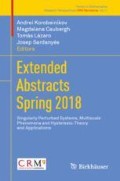Abstract
In two previous papers, we have proposed a new method for proving the existence of “canard solutions” on one hand for three- and four-dimensional singularly perturbed systems with only one fast variable and, on the other hand, for four-dimensional singularly perturbed systems with two fast variables; see [4, 5]. The aim of this work is to extend this method, which improves the classical ones used till now to the case of three-dimensional singularly perturbed systems with two fast variables. This method enables to state a unique generic condition for the existence of “canard solutions” for such three-dimensional singularly perturbed systems which is based on the stability of folded singularities (pseudo singular points in this case) of the normalized slow dynamics deduced from a well-known property of linear algebra. Applications of this method to a famous neuronal bursting model enables to show the existence of “canard solutions” in the Hindmarsh–Rose model.
This work is supported by the Ministerio de Economía, Industria y Competitividad, Agencia Estatal de Investigación grants MTM2016-77278-P (FEDER) and MDM-2014-0445, the Agència de Gestió d’Ajuts Universitaris i de Recerca grant 2017SGR1617, and the H2020 European Research Council grant MSCA-RISE-2017-777911. The first author would like to thank Prof. J. Llibre for his kind invitation to visit Universitat Autònoma de Barcelona.
Access this chapter
Tax calculation will be finalised at checkout
Purchases are for personal use only
References
J. Argémi, Approche qualitative d’un problème de perturbations singulières dans \(\mathbb{R}^4\), Equadiff, ed. by R. Conti, G. Sestini, G. Villari, vol. 1978, (1978) pp. 330–340
E. Benoît, Systèmes lents-rapides dans \(\mathbb{R}^3\) et leurs canards. Astérisque 109–110, 159–191 (1983)
E. Benoît, C. Lobry, Les canards de \({\mathbb{R}^3}\). Cr. Acad. Sc. Paris Série I 294, 483–488 (1982)
J.M. Ginoux, J. Llibre, Canards in memristor’s circuits, in Qualitative Theory of Dynamical Systems (2015), pp. 1–49
J.M. Ginoux, J. Llibre, Canards existence in FitzHugh–Nagumo and Hodgkin–Huxley neuronal models. Math. Prob. Eng. 15, Article ID 342010, 17 (2015)
J.M. Ginoux, J. Llibre, K. Tchizawa, Canards existence in the Hindmarsh–Rose model, in Proceedings of the workshop MURPHYS-HSFS-2018
J.M. Ginoux, B. Rossetto, Slow manifold of a neuronal bursting model, in Emergent Properties in Natural and Artificial Dynamical Systems, Understanding Complex Systems, ed. by M.A. Aziz-Alaoui, C. Bertelle (Springer, Berlin, 2006), pp. 119–128
J.L. Hindmarsh, R.M. Rose, A model of neuronal bursting using three coupled first order differential equations. Proc. R. Soc. Lond. Ser. B Biol. Sci. 221, 87–102 (1984)
A.L. Hodgkin, A.F. Huxley, A quantitative description of membrane current and its application to conduction and excitation in nerve. J. Physiol. Lond. 117, 500–544 (1952)
E.A. Shchepakina, Three scenarios for changing of stability in the dynamic model of nerve conduction, in Mathematical Modelling, Information Technology and Nanotechnology (ITNT-2016), vol. 1638 (2016), pp. 664–673
A. Shilnikov, M. Kolomiets, Methods of the qualitative theory for the Hindmarsh-Rose model: a case study, a tutorial. Int. J. Bifurc. Chaos 18(8), 2141–2168 (2008)
P. Szmolyan, M. Wechselberger, Canards in \(\mathbb{R}^3\). J. Diff. Equ. 177, 419–453 (2001)
K. Tchizawa, On relative stability in 4-dimensional duck solutions. J. Math. Syst. Sci. 2(9), 558–563 (2012)
K. Tchizawa, On the two methods for finding 4-dimensional duck solutions. Appl. Math. Sci. Res. Publ. 5(1), 16–24 (2014)
M. Wechselberger, À propos de canards. Trans. Amer. Math. Soc. 364, 3289–3309 (2012)
Author information
Authors and Affiliations
Corresponding author
Editor information
Editors and Affiliations
Rights and permissions
Copyright information
© 2019 Springer Nature Switzerland AG
About this paper
Cite this paper
Ginoux, JM., Llibre, J., Tchizawa, K. (2019). Canards Existence in the Hindmarsh–Rose Model. In: Korobeinikov, A., Caubergh, M., Lázaro, T., Sardanyés, J. (eds) Extended Abstracts Spring 2018. Trends in Mathematics(), vol 11. Birkhäuser, Cham. https://doi.org/10.1007/978-3-030-25261-8_26
Download citation
DOI: https://doi.org/10.1007/978-3-030-25261-8_26
Published:
Publisher Name: Birkhäuser, Cham
Print ISBN: 978-3-030-25260-1
Online ISBN: 978-3-030-25261-8
eBook Packages: Mathematics and StatisticsMathematics and Statistics (R0)

